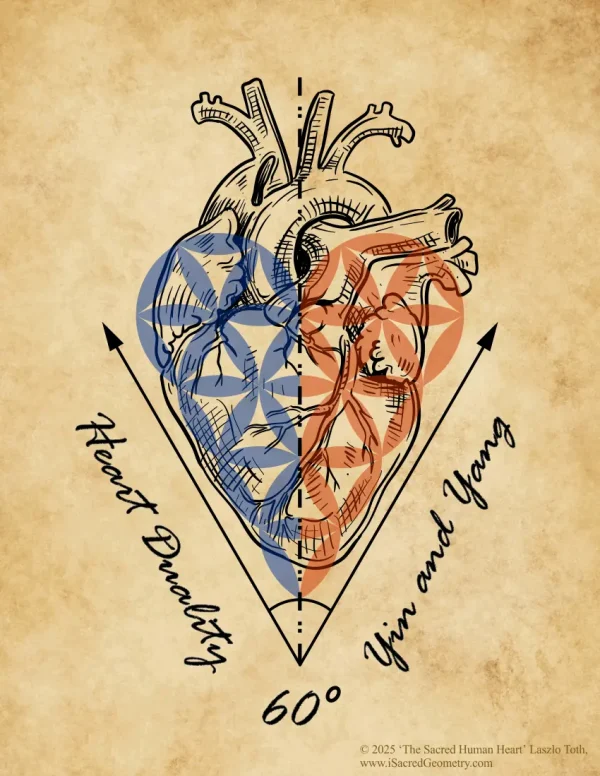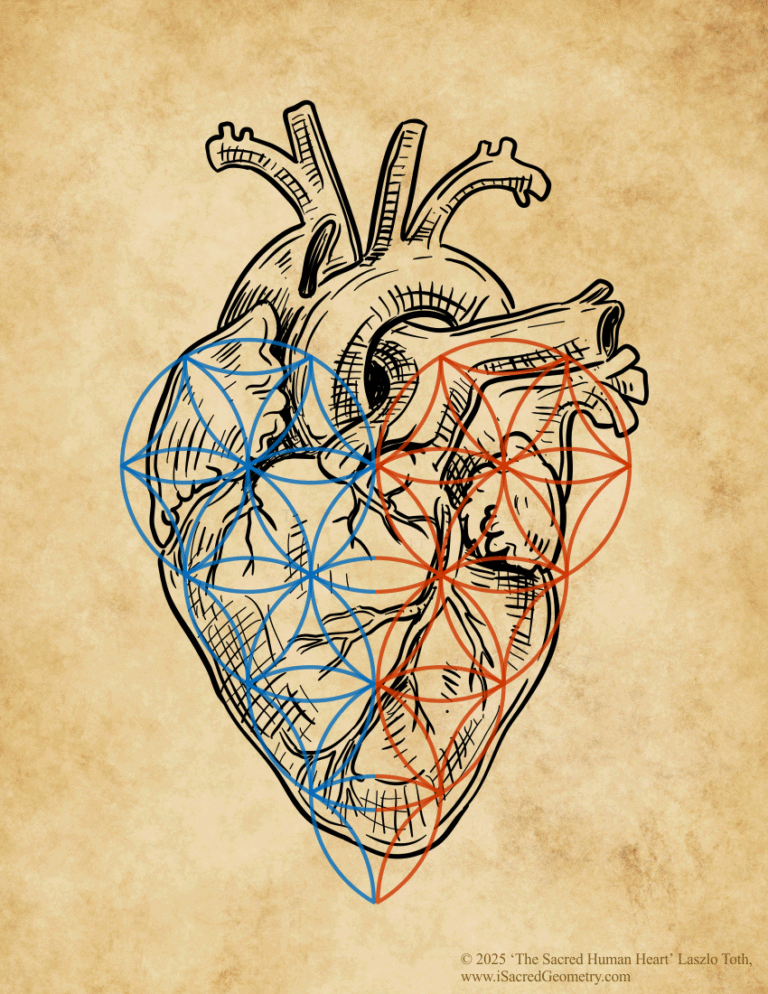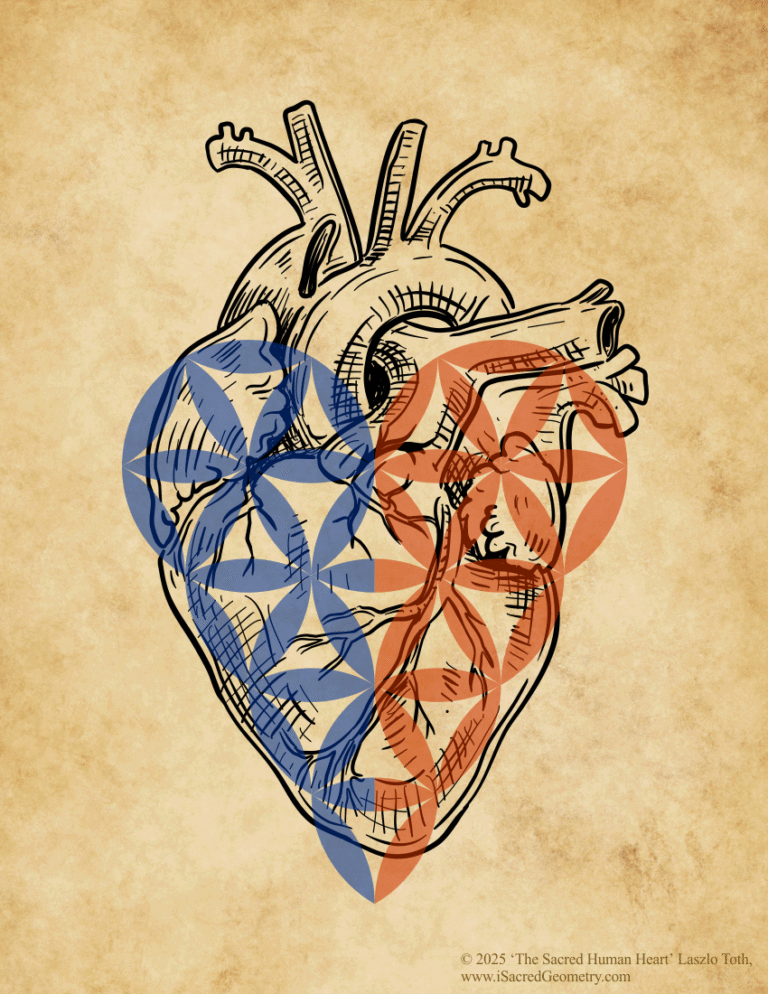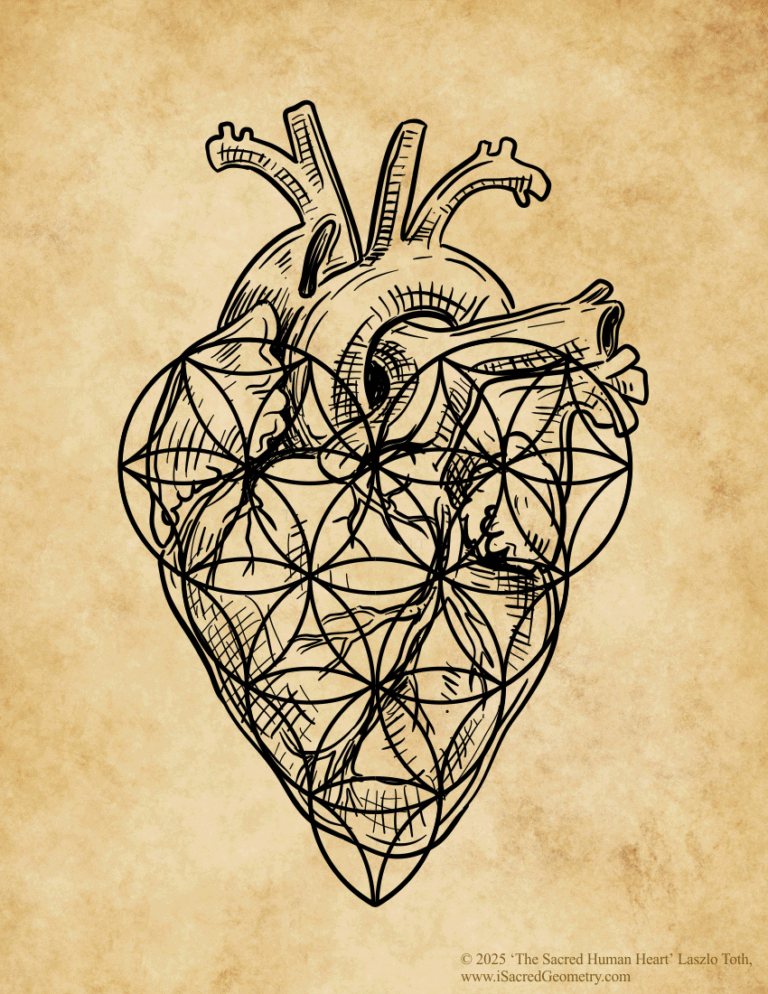The Hidden Geometry Within the Heart
The proposed composition consists of two layered elements: an anatomically accurate drawing of the human heart, and above it, a translucent Sacred Heart motif rendered in red and blue hues. The form of the Sacred Heart highlights the human heart’s geometric beauty, symmetry, proportions, and texture. Like a spiritual lens, it elevates the visual experience into a new dimension – revealing that the structure of the human body is not only biological, but also aligned with a cosmic order.
The human heart is more than a biological organ. It is a living structure reflecting the fundamental patterns of nature and the universe. Sacred geometry — the ancient system behind life’s harmony — appears not only in plants and crystals but also clearly in the shape of the human heart.
This harmony suggests that the fundamental patterns of life — the ancient laws of sacred geometry — are deeply embedded in the innermost order of the human heart. This harmony is not a mere visual coincidence, but a beautiful manifestation of the universe’s coherence and the deeper meaning of existence.
The V-Shape and the 60-Degree Angle
A key element of the composition is the V-shaped opening at the bottom of the heart. The angle between the two lines is exactly 60 degrees, a number of great significance in sacred geometry:
- 60° is the internal angle of an equilateral triangle, symbolizing creation and balance.
- It forms the basis of a hexagon, a regular six-sided figure.
- The “Flower of Life,” an ancient geometric pattern, is also based on this structure.
- This angle appears in the structure of snowflakes, honeycombs, and many other natural forms.
The exact alignment of the heart’s shape with this 60-degree structure reflects a cosmic pattern. This is not only aesthetic harmony but sacred precision.
The Apex of the Human Heart – Apex Cordis
According to medical anatomy, the apex of the heart (Latin: apex cordis) is the bottom tip of the left ventricle, pointing downward, forward, and to the left. It is located approximately in the fifth left intercostal space, about 9 cm from the midline of the sternum. This is the point where the strongest impulse—the apex beat—can be palpated, often used in clinical examinations.
This point precisely coincides with the lowest point of the sacred geometric heart, where the overlapping vesica piscis petal shapes intersect and where the V-shape converges. Thus, the 60-degree sacred angle and the anatomical apex cordis meet exactly.
The Fusion of Science and Symbolism
This coincidence is more than chance; it reveals that the form and function of the human heart follow the same sacred geometric laws governing the cosmos. The apex of the heart is not only the engine of life but also a geometric anchor where universal order meets human anatomy.
Duality of the Sacred and Human Heart
The human heart is both a living organ and a sacred symbol. Its dual nature is reflected in its anatomical structure as well as in deeper spiritual interpretations, linking body and soul, biology and philosophy.
Physical Dualism
The right and left sides of the heart reflect this dualism: both sides contain an atrium and a ventricle arranged symmetrically, operating two distinct circulatory systems — the right side pumps blood to the lungs, while the left side pumps it to the rest of the body. This physical parallel forms the foundation of life’s essential functioning.
Visual Representation in the Sacred Heart
In the designed Sacred Heart motif, this dualism takes on visual form: on either side of the heart, translucent red and blue hues appear, simultaneously referencing anatomical reality and the symbolism of the yin-yang philosophy. The red side represents the body’s warm, active energy, while the blue side symbolizes the cool, receptive energy of the soul.
The “Germ of Life” Pattern
Within the atrial regions — right and left — the symmetrical pattern of the “Germ of Life” geometry appears. This ancient symbol of the universe’s creative force alludes to the heart’s inherent potential and harmony. The pattern expresses the balance and continuous energy exchange between the two sides, as the heart both receives and transmits life.
The Vesica Piscis and Mirror Symmetry
Beneath the Germs of Life, in the central axis, the form of the vesica piscis emerges, highlighting the heart’s perfect mirror symmetry. The axis between the two sides is itself symmetrical, signaling that the heart is not a site of opposition, but of equilibrium — dualism in service of unity.
Traditional Chinese Medicine Alignment
This dual anatomical structure closely aligns with the principles of traditional Chinese medicine: on the right side resides yang — the active, warm, outward-flowing energy — while on the left is yin — the receptive, cool, inward-turning force. This interplay does not suggest conflict, but rather expresses the harmony and unity of existence.
The Heart as a Spiritual Seat
Moreover, the heart is not merely a biological pump; it is also the seat of the soul, known in Chinese philosophy as Shen. It is the source of consciousness, emotion, and intuition, revealing the heart’s role as a bridge between body and spirit.
Conclusion: Unity Through Dualism
The Sacred Heart motif, by following the true form of the human heart, seeks to reveal this profound connection. Through the interplay of symmetrical geometry and color, the unity within dualism is unveiled — a vision that is both a work of art and a reflection of anatomical precision, embodying the harmony between nature and spirit.
Closing Thoughts
The connection between the anatomical heart and sacred geometry suggests that life is not only biological but also symbolic and spiritual. This connection manifests as a living pattern within the body, demonstrating that the heart—the center of life—carries the same divine proportions found throughout nature and the universe.
Basic Anatomical and Physiological Terms
- Dual pump function, double circulation
- Right heart and left heart
- Right atrium and right ventricle
- Left atrium and left ventricle
Traditional Chinese Medicine and Philosophy
- Dual nature of the heart
- Heart as body and spirit
- Yin and Yang of the heart
- Heart energy and spirit
- Heart as mind and organ
- Spirit lives in the heart
- Heart’s two sides
- Balance of heart energy
- Heart’s physical and spiritual roles
- Heart Qi and Shen
© 2025 Laszlo Toth




